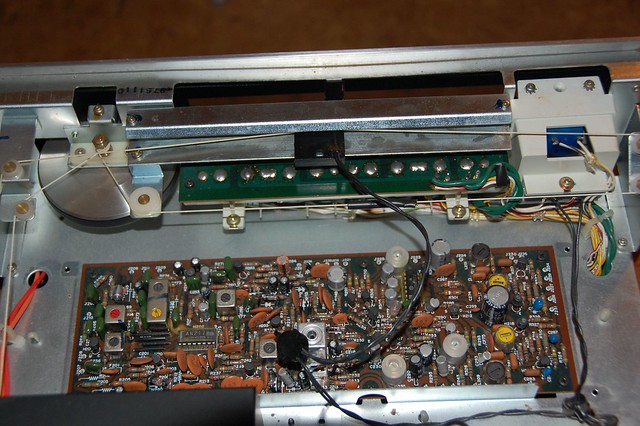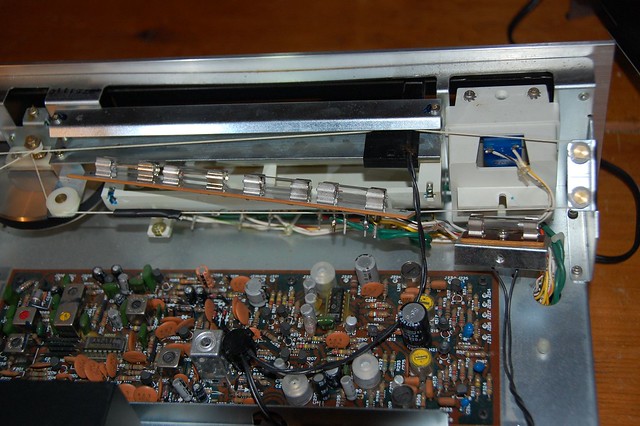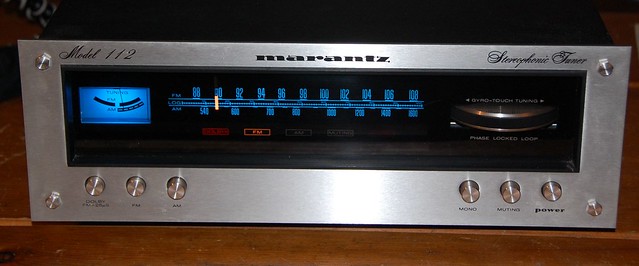I said I would get to the tuner to install the LED fuse lamps, but I did not think I would get around to it the same night. However I was so stoked on how good it looked in the receiver I had to do it.
Mostly pics in this one. Here's the best I can do at capturing the cyan green that was what I was getting with the old vellum paper and regular fuse lamps. I had to do it without the flash and a longish exposure so the rest is very dark.

It's a bit harder to get at the lamps in this tuner than the receiver I have. More screws to remove and wires in the way but it was not that hard. Case removed here is the inside.

The black cover over the tuner's main circuit board has to be removed. This view is looking toward the front at the exposed board. The long narrow green board is the where the lamp sockets are, on the underside. There were 5 screws and a clip or 2 to pull off to get this far.

The next shot is closer in. The green wires at the right are in the way as there is a screw to loosen behind them, plus one at the other end. The dial indicator string is also a bit in the way.

Exposed bulbs. You can also see that I pulled out the single lamp holder from the back of the tuning meter. It's held by one screw.

The bulbs that are about to go in are below. The one at the top is one of the original fuse lamps and the LED lamps below that. They have 2 LEDs inside each and as you can see are directional unlike the incandescents.
When I installed them I paid attention to the direction they pointed. In the 2215b I pointed them straight out as they go in directly behind the faceplate. In this tuner they are at 90 degrees to the face, and point down into a white reflector housing that redirects the light outward. This reflector is another reason the light colour can change with time as it will yellow and even sometimes get somewhat melted. I decided to turn the LEDs just a little, maybe 25 or 30 degrees forward of straight down and again make sure they all had the same angle.

The finished product is below and again it looks great. This shot was actually with the flash so looks the most realistic, and the blue stands out even against the power of the flash.

I am pretty happy with these little guys...total time to completion on this project: roughly one record side!
Mostly pics in this one. Here's the best I can do at capturing the cyan green that was what I was getting with the old vellum paper and regular fuse lamps. I had to do it without the flash and a longish exposure so the rest is very dark.

It's a bit harder to get at the lamps in this tuner than the receiver I have. More screws to remove and wires in the way but it was not that hard. Case removed here is the inside.

The black cover over the tuner's main circuit board has to be removed. This view is looking toward the front at the exposed board. The long narrow green board is the where the lamp sockets are, on the underside. There were 5 screws and a clip or 2 to pull off to get this far.

The next shot is closer in. The green wires at the right are in the way as there is a screw to loosen behind them, plus one at the other end. The dial indicator string is also a bit in the way.

Exposed bulbs. You can also see that I pulled out the single lamp holder from the back of the tuning meter. It's held by one screw.

The bulbs that are about to go in are below. The one at the top is one of the original fuse lamps and the LED lamps below that. They have 2 LEDs inside each and as you can see are directional unlike the incandescents.
When I installed them I paid attention to the direction they pointed. In the 2215b I pointed them straight out as they go in directly behind the faceplate. In this tuner they are at 90 degrees to the face, and point down into a white reflector housing that redirects the light outward. This reflector is another reason the light colour can change with time as it will yellow and even sometimes get somewhat melted. I decided to turn the LEDs just a little, maybe 25 or 30 degrees forward of straight down and again make sure they all had the same angle.

The finished product is below and again it looks great. This shot was actually with the flash so looks the most realistic, and the blue stands out even against the power of the flash.

I am pretty happy with these little guys...total time to completion on this project: roughly one record side!
Thanks for this. Apparently not many people care about their old Marantz 112, maybe there weren't that many out there. I had two bulbs still working but wanted the others to work. This is taking me a long time. I finally figured out how to get the green board out, which was tricky because it had melted a lot and prevented the board from coming out easily. My question for you is how did you get each bulb out?? I'm afraid of breaking them, oh, what a mess that would be! Did you have a fuse puller? I'm going to have to get one before I do something really dumb. I think I understand what you're saying about angling the bulb, but further clarification would help as I'm not as familiar with the LED bulbs, although I own the replacements I need. I'm going to be happy when this is done, IF I can get the tuner string to back the way it was...that could be a bit tricky. But seriously, "one record side"?? Are you an especially gifted technician?? ;) Thanks again.
ReplyDeleteThe receiver or tuner is a dying breed, but they just look so cool. And I do still listen to the radio, even AM.
ReplyDeleteGetting the bulbs out is not that hard. I've changed them on quite a few different models of receivers and tuners now and some are definitely easier than others. I am fairly dexterous but not "especially gifted". Definitely persistent though...
I will usually just try to pop out one end with a screwdriver, and then grab the metal part at the free end with my long needle nose pliers. If you have a set of long tweezers or a hemostat that might work too. You could wrap the tips in a rubber band to get a better grip without having to pinch too hard and risk breaking the glass. I think I've only broken one or two doing this. Sometimes I will drop one and might have to get creative to snake it out depending on where it falls but they can always be retrieved.
Rotating the bulbs can help prevent too much of a hot spot, as in too bright or a non-uniform glow. I just played with this a bit and it worked out fine. Depending on your LED brightness you might try more or less. Aim for the same angle though as it will bug you if one area is different in brightness from the rest.
Be careful when you put in the screws that hold the plastic reflector. Those little taps will be brittle after all these years and the bulb heat so can easily break. Thankfully you don't need much torque to hold it in place.
Good luck!